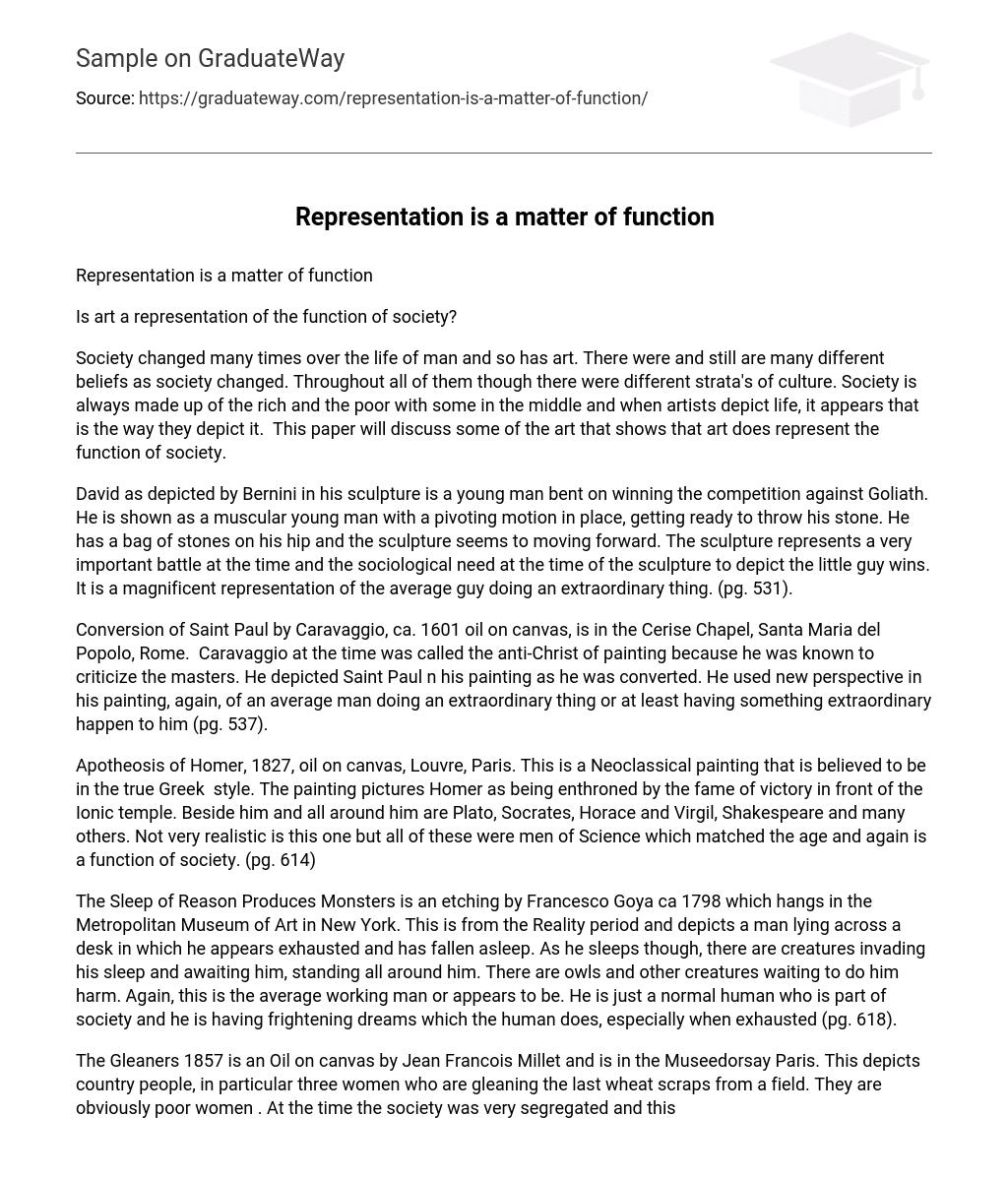Is art a representation of the function of society?
Society changed many times over the life of man and so has art. There were and still are many different beliefs as society changed. Throughout all of them though there were different strata’s of culture. Society is always made up of the rich and the poor with some in the middle and when artists depict life, it appears that is the way they depict it. This paper will discuss some of the art that shows that art does represent the function of society.
David as depicted by Bernini in his sculpture is a young man bent on winning the competition against Goliath. He is shown as a muscular young man with a pivoting motion in place, getting ready to throw his stone. He has a bag of stones on his hip and the sculpture seems to moving forward. The sculpture represents a very important battle at the time and the sociological need at the time of the sculpture to depict the little guy wins. It is a magnificent representation of the average guy doing an extraordinary thing. (pg. 531).
Conversion of Saint Paul by Caravaggio, ca. 1601 oil on canvas, is in the Cerise Chapel, Santa Maria del Popolo, Rome. Caravaggio at the time was called the anti-Christ of painting because he was known to criticize the masters. He depicted Saint Paul n his painting as he was converted. He used new perspective in his painting, again, of an average man doing an extraordinary thing or at least having something extraordinary happen to him (pg. 537).
Apotheosis of Homer, 1827, oil on canvas, Louvre, Paris. This is a Neoclassical painting that is believed to be in the true Greek style. The painting pictures Homer as being enthroned by the fame of victory in front of the Ionic temple. Beside him and all around him are Plato, Socrates, Horace and Virgil, Shakespeare and many others. Not very realistic is this one but all of these were men of Science which matched the age and again is a function of society. (pg. 614)
The Sleep of Reason Produces Monsters is an etching by Francesco Goya ca 1798 which hangs in the Metropolitan Museum of Art in New York. This is from the Reality period and depicts a man lying across a desk in which he appears exhausted and has fallen asleep. As he sleeps though, there are creatures invading his sleep and awaiting him, standing all around him. There are owls and other creatures waiting to do him harm. Again, this is the average working man or appears to be. He is just a normal human who is part of society and he is having frightening dreams which the human does, especially when exhausted (pg. 618).
The Gleaners 1857 is an Oil on canvas by Jean Francois Millet and is in the Museedorsay Paris. This depicts country people, in particular three women who are gleaning the last wheat scraps from a field. They are obviously poor women . At the time the society was very segregated and this painting may have pleased the rich by showing that the poor are still poor. These women depict the lowest of the groups which is the country peasant (pg. 632).
Rue Transnonarn 1834 is a lithograph done by Honore Daumier and is in the Philadelphia Museum of Art. This is a depiction of a terrible thing that happened on a street this painting was named after. In this case, someone from the housing area, a sniper, shot and killed a policeman and the rest of the policemen opened fire on all the inhabitants of the area, massacring many. This is a full depiction of the common man, these were working class people, who were killed for something one man did. A part of society? It is not to believe it might still happen today (pg. 648)
Saying Grace, oil on canvas was painted by Jean-Batiste Simeon Chardon in 1740 and hangs in the Louvre in Paris. This is a quiet family scene of domestic life in which a mother and her young children are getting ready for the evening meal and are saying prayers before the dine. Society at this time was generally very corrupt but the average man was humble and domestic as depicted in this painting (pg.592).
Anatomy Lesson of Dr. Tulp, oil on canvas was done by Rembrandt van Ryn. This truly is an interesting painting of the time. Dr. Tulp was a famous surgeon and this depicts him in the surgical suite with students doing a dissection of a corpse. Because of the work that was done in that period, we have the kinds of surgery we have today. This is a very clear depiction of what was really going on in society although this was not an acceptable practice at the time (pg. 588).
Louis Le Nain painted Family of Country People, ca 1640 on canvas which hangs in the Louvre in Paris. This reflects the 17th century thinking about social theory and the natural virtue of peasants who worked the soil. These were the hard working people that held society together even though they had nothing themselves. They lived during very hard times in which they often had to fight for what little they had (pg 572).
In conclusion, art does represent the functions of society and often depicts the hardest parts of society including the poor and the mistreated. Many times as we gaze at a painting, we feel the pain, joy, love, and hate of the period. Art is not always beautiful but neither is life and if we are going to represent society and how they live we must sometimes reflect the ugly with the beautiful. What can be more strengthening to anyone though than the depiction of David, the common man about to fight the battle against the giant?
References





